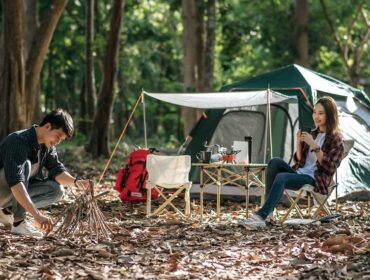As outdoor enthusiasts become more environmentally conscious, the demand for sustainable camping gear continues to grow. This guide explores the world of eco-friendly camping equipment, highlighting its importance and showcasing innovative categories for a greener outdoor experience.
Introduction to Sustainable and Eco-Friendly Camping Gadgets
In recent years, the camping industry has witnessed a remarkable shift towards sustainability. Eco-friendly camping gadgets are at the forefront of this green revolution, offering innovative solutions that minimize environmental impact without compromising on performance or comfort. These sustainable gadgets range from solar-powered devices and biodegradable materials to multifunctional tools that reduce waste.
The rise of eco-friendly camping gear reflects a growing awareness among outdoor enthusiasts about the importance of preserving the natural spaces we love to explore. These gadgets not only help reduce our carbon footprint but also often provide enhanced functionality and durability compared to their traditional counterparts. As technology advances, we’re seeing an exciting fusion of cutting-edge design and environmental responsibility in the world of camping equipment.
Why Choose Sustainable Camping Gear?
Sustainable camping gear is designed with the environment in mind. These products are often made from recycled materials, built to last longer, and created using processes that minimize environmental impact. By choosing eco-friendly gear, you’re reducing your carbon footprint and helping to preserve the natural spaces we all love to explore. Sustainable products are often built to last, meaning you’ll replace them less frequently, saving money in the long run and reducing waste. Many companies producing sustainable gear prioritize fair labor practices and responsible sourcing of materials. The push for sustainability has led to creative solutions and cutting-edge materials that often outperform traditional options.
Let’s explore some key categories of sustainable camping gear:
Tents
Eco-friendly tents are made from recycled materials and designed for longevity. Look for options that use PFC-free waterproofing and recycled fabrics. Many sustainable tents feature poles made from recycled aluminum, making them a top choice for the environmentally conscious camper.
Sleeping Bags
Sustainable sleeping bags often use recycled materials for both the outer shell and insulation. Many combine shells made from recycled plastic bottles with ethically sourced, recycled down insulation. These bags are warm, compressible, and kind to the planet.
Hammocks

For those who prefer sleeping under the stars, eco-friendly hammocks offer a sustainable alternative to traditional tents. Look for hammocks made from recycled materials or sustainable fabrics like organic cotton. These lightweight options not only reduce your pack weight but also minimize impact on the forest floor. Many come with tree-friendly straps to protect bark from damage.
Camping Stoves

Look for stoves that use renewable fuel sources or maximize fuel efficiency to reduce your environmental impact. Some innovative stoves burn small twigs and pine cones, eliminating the need for fossil fuels. Certain models even generate electricity to charge your devices while you cook.
Water Filtration Systems
Sustainable water filters help you avoid single-use plastic bottles while ensuring safe drinking water. Many eliminate the need for pumping or batteries, using gravity instead. Look for filters made with BPA-free plastics and long-lasting components that reduce plastic waste.
Solar-Powered Gadgets

Solar chargers and lights reduce reliance on disposable batteries and provide renewable energy for your devices. Foldable solar panels that charge devices directly from the sun are lightweight, durable, and perfect for keeping electronics powered in the backcountry.
Portable Solar Panels
Take your sustainable power generation a step further with portable solar panels. These lightweight, foldable panels can be attached to your backpack during hikes or set up at your campsite. They provide a reliable source of clean energy to charge your devices, reducing reliance on disposable batteries and fossil fuels. Look for models with high efficiency ratings and durable construction for long-lasting performance in outdoor conditions.
Eco-Friendly Clothing
Sustainable camping clothing is made from recycled materials or renewable resources like organic cotton or hemp. These fabrics are often breathable and moisture-wicking, requiring less water and no pesticides to grow compared to conventional cotton.
Biodegradable Camping Soap
Choose multi-purpose, biodegradable soaps to minimize your impact on the local ecosystem. Look for versatile, biodegradable options that can be used for dishes, laundry, and personal hygiene. These soaps should be free from harsh chemicals and safe for use in the backcountry.
Sustainable Backpacks

Look for packs made from recycled materials that are built to last. Many durable daypacks and larger backpacks are now made entirely from recycled plastic bottles. These packs often feature comfortable designs and multiple compartments for organization.
Bamboo Utensil Sets

Replace disposable plastic utensils with durable, biodegradable bamboo utensil sets. These lightweight kits often include a fork, spoon, knife, and sometimes chopsticks, all made from sustainably harvested bamboo. They’re reusable, easy to clean, and won’t add much weight to your pack. Plus, when they eventually wear out, they’ll biodegrade naturally without harming the environment.
Base Camper Cooksets
Invest in a high-quality, sustainable cook set for your base camp. Look for options made from recycled materials or sustainable metals like titanium. These cookies often nest together for easy packing and include multiple pots, pans, and sometimes plates or bowls. By bringing durable cookies, you’ll avoid disposable options and have reliable gear that lasts for years of adventures.
Rechargeable Lighters
Say goodbye to disposable plastic lighters and hello to rechargeable electric lighters. These innovative gadgets use a small electric arc to light your campfire or stove, eliminating the need for butane or other fossil fuels. They’re windproof and waterproof and can be recharged via USB, making them a perfect addition to your sustainable camping kit. Plus, you’ll never have to worry about running out of fuel in the middle of your trip.
Tips for Sustainable Camping Practices
Using eco-friendly gear is just the first step toward truly minimizing your impact while camping. Following Leave No Trace principles is essential. Always aim to leave nature exactly as you found it, if not better. This means taking all waste with you and being mindful of your surroundings.
Before heading out:
- Consider repackaging food into reusable containers to reduce plastic waste.
- Avoid single-use items by bringing reusable alternatives like metal utensils, cloth napkins, and durable water bottles.
- Power your gadgets with solar chargers or use rechargeable batteries, helping cut down on disposable waste.
Be thoughtful in choosing your campsite-stick to established sites to prevent damage to sensitive areas. Use biodegradable soap and dispose of wastewater at least 200 feet away from lakes or streams to keep waterways clean. Lastly, support local communities by buying your camping supplies from small businesses near your destination, fostering a positive impact beyond just your footprint.
The Future of Sustainable Camping
The camping industry continues to innovate in sustainability. We’re seeing advancements in biodegradable materials, more efficient solar technology, and gear designed for easy repair and recycling. Some companies are exploring rental and buy-back programs to extend the life of camping equipment. As campers, we play a crucial role in driving demand for sustainable products and practices. By choosing eco-friendly gear and camping responsibly, we’re not just preparing for a trip—we’re investing in the future of our outdoor spaces. Every sustainable choice we make contributes to preserving the natural world for future generations of adventurers.
Conclusion
Engaging sustainable camping gear is about protecting the natural spaces we love. With eco-friendly gear like solar-powered gadgets and recycled-material tents, you can enjoy performance and durability while reducing your impact. By choosing sustainable alternatives, we all become stewards of the environment. So, as you prepare for your next adventure, consider the gear you use easier than ever to explore responsibly. Let’s leave only footprints and take only memories. Happy trails!





